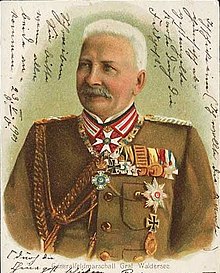Walderseeschößchen
The Walderseeschlößchen is a listed residential building at Stresemannplatz 3 in Dresden - Striesen . It is one of the late buildings of Dresden Art Nouveau architecture. The plastered building is characterized by a differentiated structure and decoration in a mixed style consisting of Neo-Baroque , Art Nouveau and Vienna Secession .
Location and surroundings
The building is on Stresemannplatz, which was called Walderseeplatz before the war and was named after Alfred von Waldersee . The name of the building is derived from the former name of the square.
history
The building was constructed for Carl August Eichler from 1906 to 1907. It was probably designed according to Colditz's designs. The building was redeveloped in the late 1990s. The tenant on the first floor was the architect Paul Colditz .
description
The two-storey mansion house with a staggered hipped and mansard roof has semicircular tower oriels at the corners of the upper storeys . The facade shows a three-storey, four-axis central risalite with a portal and an oval- shaped, curved gable as the upper end. The two corners of the building facing Stresemannplatz are emphasized by massive round bay windows. The portal shows sandstone pillars with two reclining lions , in between there is an ornamental grille with Art Nouveau elements . The fencing is wrought iron and curvy.
The interior shows a lush ceiling decoration consisting of stucco and frescoes in Art Nouveau style. In the entrance area there are three picture fields above the ornamentally decorated plinths of the two side walls, the middle of which show allegories in the form of women with open wings. The allegory on the left holds a rolled-up construction plan in the right hand, while the goddess of victory appears in her raised left hand. The triangle and circle in the decorative field below make it clear that the female figure symbolizes architecture. Opposite an allegorical female figure holds a palette and brush. These murals refer to Carl August Eichler, who was probably also a trained master painter. The ceiling painting in the hallway is not in the strict Art Nouveau style, but rather shows traditionally naturalistic two naked angels holding a panel of fabric blowing in the wind. The rest of the stairwell is decorated with line patterns and friezes, small picture fields show Mediterranean landscapes.
literature
- Volker Helas, Gudrun Peltz: Art Nouveau architecture in Dresden . Knop, Dresden 1999, ISBN 3-934363-00-8 , p. 200; Photo 251, 252, 254 and 261.
- Handbook of German Art Monuments : Dresden. Deutscher Kunstverlag, Munich 2005, p. 106.
Web links
Individual evidence
- ^ Mathias Donath, Jörg Blobelt: Angels in the hallway. Decorative art in Dresden residential buildings. edition Sächsische Zeitung, Dresden 2009, page 67.
Coordinates: 51 ° 2 ′ 36 ″ N , 13 ° 46 ′ 22 ″ E


